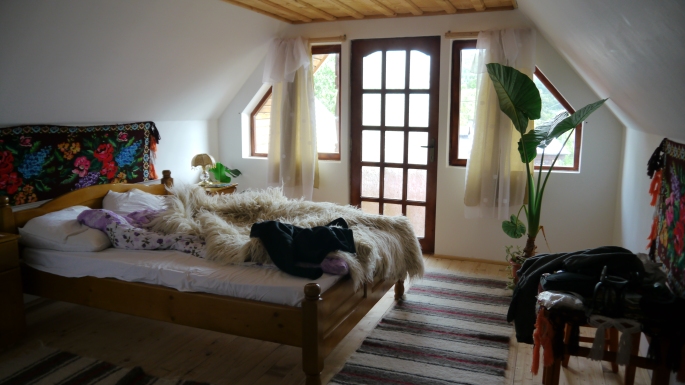Text by Stax. Photos by Beej.
By the time we leave Romania, I’m going to be fat. They’re going to have to roll me out onto the tarmac at the airport. Or better yet, just float me across the sea like a bottle.
After our long confinement on flights from Eugene to Seattle to Los Angeles to Oslo to Budapest, then the train to Cluj-Napoca, Romania, and finally our trip by car north to Breb, a nice open float doesn’t seem so bad.
When delicious food is combined with generous people who will keep feeding you until there is nothing left to feed you, it doesn’t bode well for the ol’ waistline. Our diet in Maramures consists of homemade broths and soups with tripe and other fats from various pigs, cows and sheep; potatoes, tomatoes, cucumbers, cabbage, peppers and herbs fresh from the garden; mushrooms gathered from the hills; and bread. Lots and lots of bread that magically refills your basket when you turn your head away.
So Breb. Where the heck is it and why are we here?
It all goes back to last year. When Beej and I traveled through Romania, we were told that if “traditional” weddings were what we sought, we needed to head to Maramures. And Breb is famously one the most traditional villages in the the region. So that’s where we be.
Our tiny European-made Ford Ka bubble car, with its lawnmower engine, can barely handle the grades as we descend into Breb from the narrow highway zigzagging above.The fields spread down below us all the way to the base of the distant Gutai Mountains. The small fields are dotted with towering haystacks in that distinctive Romanian style – bell-shaped surrounding a central pole, which we are told keeps the water from rotting the hay over the winter and thus keeps animals alive.
We pass a big white church with two towers and lots of rustic wooden houses that look handmade. Smoke rises from chimneys, obscuring the view as the pavement degrades to dirt and mud scattered with fist-sized rocks unearthed by the recent rainfall. The road narrows even more as we struggle in first gear toward Babou Maramures Hostel. Sometimes we have to stop for long minutes to let teams of horses pulling wooden carts full of pumpkins, hay, or tree limbs pass us by. I feel like we’ve entered into the Shire–if we give ourselves enough time, we may just find Hobbiton.
Elderly women in traditional dress (patterned scarves, baggy black dresses, wool leggings, boots) – some carrying mean-looking scythes across their backs from the fields – stop us for a chat. They can’t speak English and we can’t speak Romanian, but somehow we manage. The two most common phrases we hear: “Buna seară” (good evening) and “De unde sunteti?” (where are you from).
“America,” we answer. They nod their heads in amazement. “Ahhhh…Amehreecaaaaah.” Sometimes they raise their hand to mimic a plane, suggesting we’ve come a long, long way.
For our first night, we stay at Pensiunea Maramou, a farm bed-and-breakfast owned and operated by a local woman, Maria, and her mother. We had planned to stay at the hostel, but they were booked.
I can’t complain. Though the cost is twice as much as the hostel, the comfort and free meals makes it seem like a steal at 100 RON a night per person: a beautifully decorated room with hand-woven wool rugs and heavy sheepskin comforter on the bed for maximum coziness, plus an all-you-can-stuff-your-face home-cooked breakfasts and dinners made mostly fresh from the animal products on the farm. To top it off there is a nice view of the town from our room.
That first night at dinner, we chat with Mihai, the Romanian head of an ecological NGO, and two Icelandic National Park rangers who are staying at the Pensiunea. They all met 15 years ago during a National Park exchange between Iceland and Romania, and the three have been visiting each other in their respective countries ever since.
(In a weird sort of coincidence, Mihai and his NGO, Romanian Ranger Association, had written one of the first papers detailing the environmental destruction of the planned Rosia Montana gold mine back in 2001, when it was first proposed. We had gone to the FanFest at Rosia Montana a year before and met the filmmaker whose documentary chronicles the movement against the mine. Small world we meet someone so influential in that movement, which grew to encompass the E.U., here in Maramures a year later.)
Our talk is only interrupted by Maria and her mother try to burst our stomachs by giving us more food or to admonish us laughingly for not drinking enough horincă. We try to explain that while they’ve been working up huge appetites working in fields and farms, we have been sitting in a car.
And we can’t be blamed for going easy on the horincă, a clear plum-based sort of brandy distilled by everyone and their mothers in Maramures. While all ţuica is strong, the Maramureş version, horincă, will clean your insides. One sip from my tiny shot glass and I feel like I’m breathing fire.
So anyway, here we are in what could easily be Middle Earth, but on our own Fellowship journey to find traditional weddings. We aim to spend the next week narrowing down our search. And we’re starting, of course, with the wooden churches.
More on that in the next post!







Love reading your posts, so informative and makes me feel like I’m there. Love you both
Thank you Joy! We hope to make it to Zac’s wedding in Phuket – we’re working on being able to film a traditional wedding in India so we’ll be (somewhat) nearby! We’ll keep you posted.